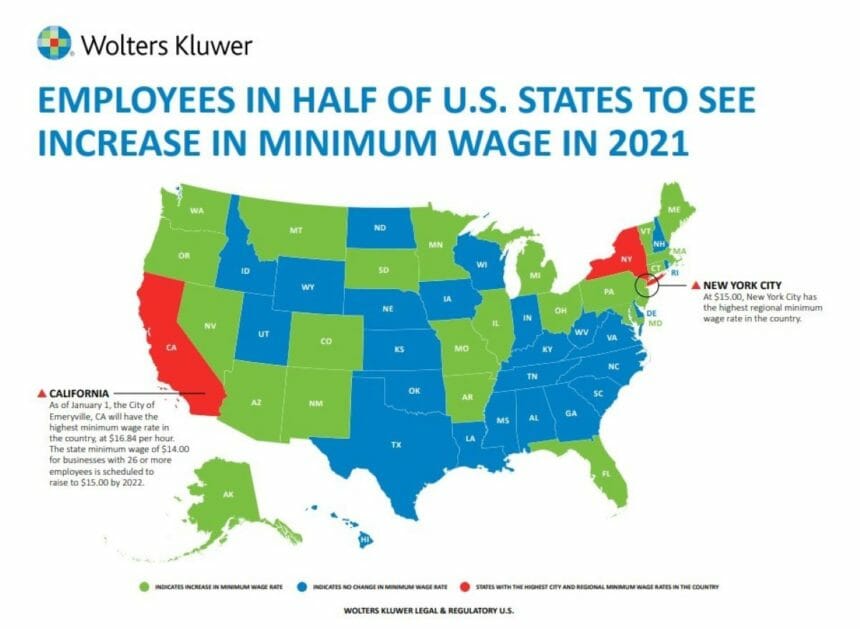Twenty states and 32 cities and counties increased their minimum wage as of Jan. 1, with 27 of these jurisdictions reaching or exceeding $15 an hour, according to the National Employment Law Project.
This is the highest number of jurisdictions raising pay since the “Fight for $15” began in 2012, the organization said. The NELP report said the wage increases are needed now more than ever as the country faces a pandemic-led health and economic crisis.
In response to the pandemic, New Jersey established a minimum wage for direct care workers employed by long-term care facilities. As of September 2020, the minimum wage for these workers was $3 higher than the state minimum wage, according to payroll experts at Wolters Kluwer Legal & Regulatory U.S.
As of Jan. 1, Emeryville, CA, has the highest minimum wage in the country, at $16.84 per hour, followed by Seattle at $16.69. The highest state rate is California at $14 per hour.
Five states and 18 local jurisdictions will increase their hourly wages later this year — 13 of them increasing to $15 or more, including the California cities of Berkeley, Emeryville, Fremont, Milpitas and San Francisco, as well as Washington, D.C. By the end of the year, 40 cities and counties will meet or exceed a $15 minimum wage.
Eleven states will increase the minimum wage based on cost-of-living adjustments from the Consumer Price Index. In 24 cities and counties, the wage floor will be adjusted for inflation.
New Mexico has the largest jump, bringing its hourly minimum up to $10.50 after a $1.50 increase. Arkansas, California, Illinois and New Jersey saw an increase of $1. Alaska, Maine and South Dakota increased hourly wages by 15 cents, whereas Minnesota increased its rate to $10.08 with an 8-cent increase.
Last November, Florida voters approved an increase in the minimum wage to $15 by 2026. On Jan. 1, the minimum wage rose to $8.65, and on Sept. 30, the wage will rise to $10. Florida joins California, Connecticut, Illinois, Maryland, Massachusetts, New Jersey and New York, as well as the District of Columbia, in voting on or enacting a plan to raise the state minimum wage to $15 or higher.
The Economic Policy Institute estimates that with these states and D.C., raising the minimum wage, about 42% of the U.S. workforce will be covered by $15 minimum wage laws by 2026.
In February 2019, Illinois approved the same $15 hourly wage by 2025.Chicago’s minimum wage will reach that $15 mark four years before the rest of the state. After the minimum wage reaches $15 an hour in Chicago on July 1, the wage will increase annually as measured by the Consumer Price Index. In 2024, employers with four to 20 workers will pay the same minimum wage as larger employers, according to the Employment Policies Institute.
The Vermont Legislature also adopted a new law, raising the state’s minimum wage to $12.55 by 2022 and requiring a report in early 2021 on the possibility of eliminating the sub-minimum tipped and youth wages.
Several cities also adopted higher minimum wage laws for the first tie in 2020 — in California, the minimum will reach $15 in Burlingame by 2021, in Half Moon Bay by 2021, in Hayward by 2023, and in San Carlos by 2021; and in Maine, it’ll reach $15 in Portland by 2024 and Rockland by 2024.
Some local cities approved minimum wages above $15, including Belmont, CA ($15.90 by 2021), Sonoma, CA ($16-$17 by 2023), and Denver, CO ($15.97 by 2022).
There are still 19 states (and Puerto Rico) with minimum wages at the federal level of $7.25 per hour: Alabama, Georgia, Idaho, Indiana, Iowa, Kansas, Kentucky, Louisiana, Mississippi, New Hampshire, North Carolina, North Dakota, Oklahoma, Pennsylvania, Tennessee, Texas, Utah, Wisconsin and Wyoming. Congress has not raised the federal minimum wage in 10 years.


